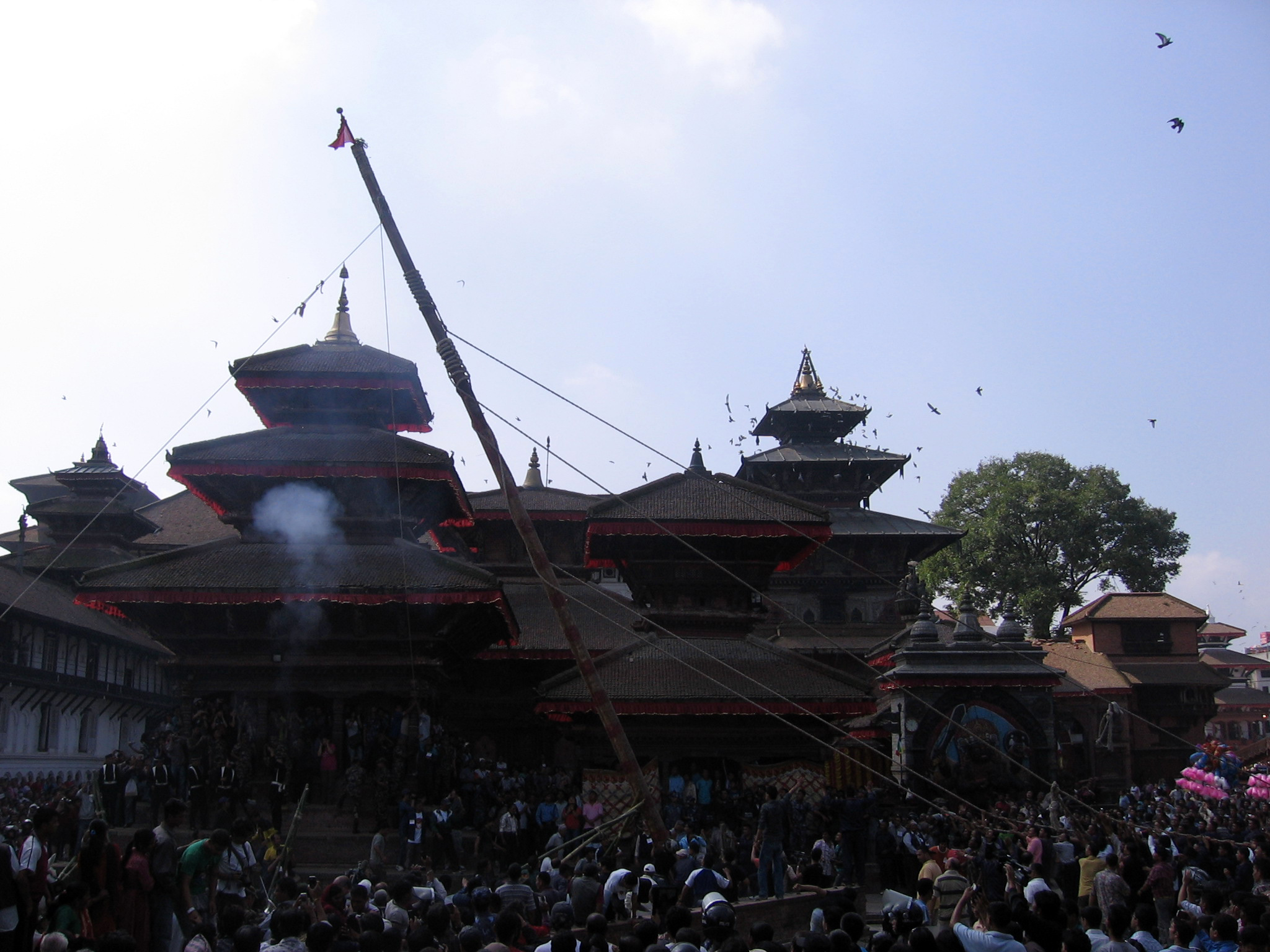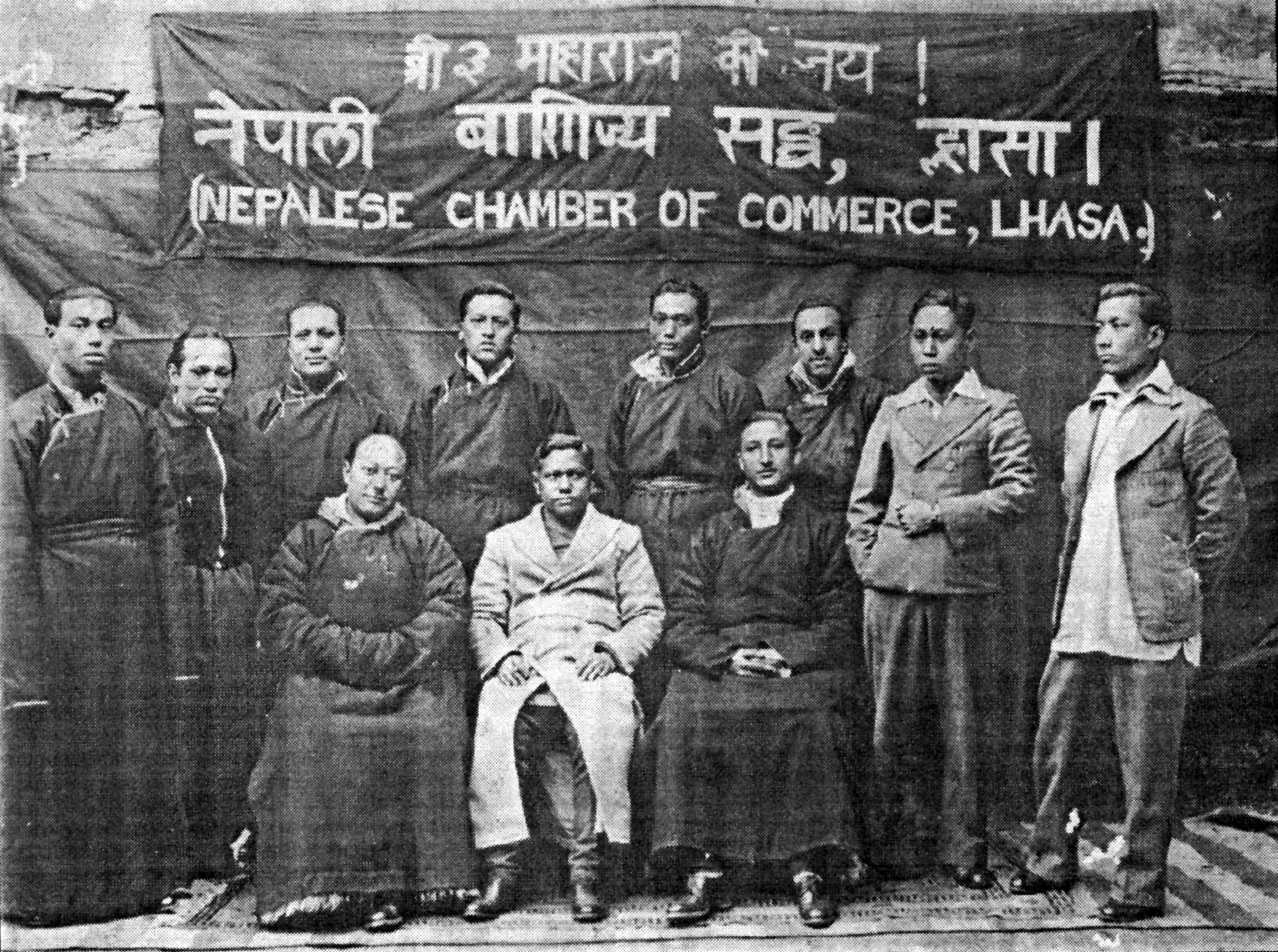|
Khyah (legendary Creature)
Khyāh (Newar language, Nepal Bhasa:) (alternative spellings Khyā, Khyāk) (ख्याक) is a mythical humanoid creature in Newari folklore. It is depicted as a fat, hairy and short ape-like creature. Khyahs appear in children's stories popular in Newar people, Newar society. A friendly Khyah fills the home with goodness while bad ones bring trouble. A white Khyah is believed to bring good luck while a black one can create problems. Encountering a Khyah can make one ill. Khyahs are said to tickle their victims to death. In Newar culture, Khyahs attend to Lakshmi, the goddess of wealth, and pictures of the deity show them guarding overflowing bags of coins. Household Khyahs usually dwell in the attic and dark storerooms. They are said to fear electric lighting. The antithesis of the Khyah is the Kawanchā, a skeleton. Khyahs and Kawanchas appear as supporting characters in sacred dance dramas of the Newars. Images of Khyahs and Kawanchas are also placed at temples as guardi ... [...More Info...] [...Related Items...] OR: [Wikipedia] [Google] [Baidu] |
Laxmi Dyah And Khyah
Lakshmi (; , sometimes spelled Laxmi, ), also known as Shri (, ), is one of the principal goddesses in Hinduism. She is the goddess of wealth, fortune, power, beauty, fertility and prosperity, and associated with ''Maya (religion), Maya'' ("Illusion"). Along with Parvati and Saraswati, she forms the Tridevi of Hindu goddesses. Within the goddess-oriented Shaktism, Lakshmi is venerated as the prosperity aspect of the Mother goddess. Lakshmi is both the consort and the divine energy (''shakti'') of the Hindus, Hindu god Vishnu, the Supreme Being of Vaishnavism; she is also the Supreme Goddess in the sect and assists Vishnu to create, protect, and transform the universe. She is an especially prominent figure in Sri Vaishnavism, in which devotion to Lakshmi is deemed to be crucial to reach Vishnu. Whenever Vishnu descended on the earth as an avatar, Lakshmi accompanied him as consort, for example, as Sita and Radha or Rukmini as consorts of Vishnu's avatars Rama and Krishna, re ... [...More Info...] [...Related Items...] OR: [Wikipedia] [Google] [Baidu] |
Newar Language
Newar (), or Newari and known officially in Nepal as Nepal Bhasa, is a Sino-Tibetan language spoken by the Newar people, the indigenous inhabitants of Nepal Mandala, which consists of the Kathmandu Valley and surrounding regions in Nepal. "Nepal Bhasa" literally means "Nepalese language", however the language is not the same as Nepali (Devanāgarī: नेपाली), the country's current official language of the central government. The two languages belong to different language families (Sino-Tibetan and Indo-European, respectively), but centuries of contact have resulted in a significant body of shared vocabulary. Newar was Nepal's administrative language from the 14th to the late 18th century. From the early 20th century until democratisation, Newar suffered from official suppression. From 1952 to 1991, the percentage of Newar speakers in the Kathmandu Valley dropped from 75% to 44% and today Newar culture and language are under threat. The language has been listed ... [...More Info...] [...Related Items...] OR: [Wikipedia] [Google] [Baidu] |
Newar People
Newar (; new, नेवार, endonym: Newa; new, नेवा, Pracalit script:) or Nepami, are the historical inhabitants of the Kathmandu Valley and its surrounding areas in Nepal and the creators of its historic heritage and civilisation. Page 15. Newars form a linguistic and cultural community of primarily Indo-Aryan and Tibeto-Burman ethnicities following Hinduism and Buddhism with Nepal Bhasa as their common language. Newars have developed a division of labour and a sophisticated urban civilisation not seen elsewhere in the Himalayan foothills. Newars have continued their age-old traditions and practices and pride themselves as the true custodians of the religion, culture and civilisation of Nepal. Newars are known for their contributions to culture, art and literature, trade, agriculture and cuisine. Today, they consistently rank as the most economically and socially advanced community of Nepal, according to the annual Human Development Index published by UNDP. Nepal ... [...More Info...] [...Related Items...] OR: [Wikipedia] [Google] [Baidu] |
Lakshmi
Lakshmi (; , sometimes spelled Laxmi, ), also known as Shri (, ), is one of the principal goddesses in Hinduism. She is the goddess of wealth, fortune, power, beauty, fertility and prosperity, and associated with ''Maya'' ("Illusion"). Along with Parvati and Saraswati, she forms the Tridevi of Hindu goddesses. Within the goddess-oriented Shaktism, Lakshmi is venerated as the prosperity aspect of the Mother goddess. Lakshmi is both the consort and the divine energy (''shakti'') of the Hindu god Vishnu, the Supreme Being of Vaishnavism; she is also the Supreme Goddess in the sect and assists Vishnu to create, protect, and transform the universe. She is an especially prominent figure in Sri Vaishnavism, in which devotion to Lakshmi is deemed to be crucial to reach Vishnu. Whenever Vishnu descended on the earth as an avatar, Lakshmi accompanied him as consort, for example, as Sita and Radha or Rukmini as consorts of Vishnu's avatars Rama and Krishna, respectively. The eight ... [...More Info...] [...Related Items...] OR: [Wikipedia] [Google] [Baidu] |
Antithesis
Antithesis (Greek for "setting opposite", from "against" and "placing") is used in writing or speech either as a proposition that contrasts with or reverses some previously mentioned proposition, or when two opposites are introduced together for contrasting effect. This is based on the logical phrase or term. Antithesis can be defined as "a figure of speech involving a seeming contradiction of ideas, words, clauses, or sentences within a balanced grammatical structure. Parallelism of expression serves to emphasize opposition of ideas". An antithesis must always contain two ideas within one statement. The ideas may not be structurally opposite, but they serve to be functionally opposite when comparing two ideas for emphasis. According to Aristotle, the use of an antithesis makes the audience better understand the point the speaker is trying to make. Further explained, the comparison of two situations or ideas makes choosing the correct one simpler. Aristotle states that antith ... [...More Info...] [...Related Items...] OR: [Wikipedia] [Google] [Baidu] |
Harald Tambs-Lyche
Harald Tambs-Lyche (born 1946) is a Norwegian ethnologist and social anthropologist. Tambs-Lyche earned a doctorate degree from the University of Bergen in 1992 with a doctoral thesis on the research subject of 'religion and society' in the Saurashtra (region), Saurashtra region of India's Gujarat. He worked at the University of Bergen as a lecturer of social anthropology and retired as a professor of ethnology from the University of Picardy Jules Verne. His research interests includes the history of social stratification and the caste system in India. Family Harald Tambs-Lyche is married to Marine Carrin. Education and academic career Tambs-Lyche did his master's in 1972 with the thesis titled "London Patidars" and his Ph.D. in 1992 with the thesis titled "Power and Devotion: Religion and Society in Saurashtra" — both from Norway's University of Bergen — and worked at the university as a lecturer of social anthropology. He is a professor emeritus of ethnology at the Univers ... [...More Info...] [...Related Items...] OR: [Wikipedia] [Google] [Baidu] |
Supporting Character
A supporting character is a character in a narrative that is not the focus of the primary storyline, but is important to the plot/protagonist, and appears or is mentioned in the story enough to be more than just a minor character or a cameo appearance. Sometimes, supporting characters may develop a complex backstory of their own, but this is usually in relation to the main character, rather than entirely independently. In television, supporting characters may appear in more than half of episodes per season. Some examples of well-known supporting characters include Watson in the Sherlock Holmes stories, Donkey in the Shrek films, and Ron Weasley in the Harry Potter series. In some cases, especially in ongoing material such as comic books and television series, supporting characters themselves may become main characters in a spin-off if they gain sufficient approval from their audience. See also * Cameo * Bit player * Henchman * Sidekick A sidekick is a slang expression for ... [...More Info...] [...Related Items...] OR: [Wikipedia] [Google] [Baidu] |
Yenya
Indra Jātrā, also known as Yenyā (Nepal Bhasa: येँयाः), is the biggest religious street festival in Kathmandu, Nepal. The celebrations consist of two events, Indra Jātrā and Kumāri Jātrā. Indra Jātrā is marked by masked dances of deities and demons, displays of sacred images and tableaus in honor of the deity Indra, the king of heaven. Kumāri Jātrā is the chariot procession of the living goddess Kumari. Family members deceased in the past year are also remembered during the festival. The main venue of the festivities is Kathmandu Durbar Square. The celebrations last for eight days from the 12th day of the bright fortnight to the 4th day of the dark fortnight of Yanlā (ञला), the eleventh month in the lunar Nepal Era calendar. Indra Jatra was started by King Gunakamadeva- (गुणकामदेव) to commemorate the founding of the Kathmandu city in the 10th century. Kumari Jatra began in the mid-18th century. The celebrations are held accordi ... [...More Info...] [...Related Items...] OR: [Wikipedia] [Google] [Baidu] |
Singing Game
A singing game is an activity based on a particular verse or rhyme, usually associated with a set of actions and movements. As a collection, they have been studied by folklorists, ethnologists, and psychologists and are seen as important part of childhood culture. The same term is also used for a form of video game that involves singing. The study of singing games Singing games began to be recorded and studied seriously in the nineteenth century as part of the wider folklore movement. Joseph Strutt's ''Sports and Pastimes of the People of England'' (1801), Robert Chambers’s ''Popular Rhymes of Scotland'' (1826), James Orchard Halliwell's ''The Nursery Rhymes of England'' (1842) and ''Popular Rhymes and Nursery Tales'' (1849), and G. F. Northal's ''English Folk Rhymes'' (1892) all included singing games.B. Sutton-Smith, J. Mechling and T. W. Johnson, ''Children's Folklore: A Source Book'' (London: Taylor & Francis, 1995), pp. 11-16. However, the first studies to focus solely ... [...More Info...] [...Related Items...] OR: [Wikipedia] [Google] [Baidu] |
Nepalese Legendary Creatures
Nepali or Nepalese may refer to : Concerning Nepal * Anything of, from, or related to Nepal * Nepali people, citizens of Nepal * Nepali language, an Indo-Aryan language found in Nepal, the current official national language and a language spoken in India * Nepal Bhasa, a Sino-Tibetan language found in Nepal, formerly the official national language * Nepalese literature * Nepalese cuisine * Nepalese culture * Nepali cinema * Nepali music Other uses * ''Nepali'' (film), a 2008 Indian Tamil-language film See also * Nepal (other) * * * Languages of Nepal * Nepal Nepal (; ne, :ne:नेपाल, नेपाल ), formerly the Federal Democratic Republic of Nepal ( ne, सङ्घीय लोकतान्त्रिक गणतन्त्र नेपाल ), is a landlocked country in S ... is a south Asian country with a population of nearly 30 million. {{disambiguation Language and nationality disambiguation pages ... [...More Info...] [...Related Items...] OR: [Wikipedia] [Google] [Baidu] |
Newar
Newar (; new, नेवार, endonym: Newa; new, नेवा, Pracalit script:) or Nepami, are the historical inhabitants of the Kathmandu Valley and its surrounding areas in Nepal and the creators of its historic heritage and civilisation. Page 15. Newars form a linguistic and cultural community of primarily Indo-Aryan and Tibeto-Burman ethnicities following Hinduism and Buddhism with Nepal Bhasa as their common language. Newars have developed a division of labour and a sophisticated urban civilisation not seen elsewhere in the Himalayan foothills. Newars have continued their age-old traditions and practices and pride themselves as the true custodians of the religion, culture and civilisation of Nepal. Newars are known for their contributions to culture, art and literature, trade, agriculture and cuisine. Today, they consistently rank as the most economically and socially advanced community of Nepal, according to the annual Human Development Index published by UNDP. Nep ... [...More Info...] [...Related Items...] OR: [Wikipedia] [Google] [Baidu] |



_(6843511981).jpg)


